This is the third installment in this new category here on colourliving, which I hope will provide some inspiration and insight for many of you.
For new readers:
Much has been written about The Creative Process, which in its purest form is simply a way of solving a problem. That sounds simple, doesn’t it? Creativity and its process, contrary to popular belief, is not just reserved for artists and designers. I believe that everyone can benefit from learning and understanding the numerous ways of the creative process. I will invite people to share their own personal creative processes with us and hope this will help you with identifying your own.
Ha. Today, i’m delighted to introduce you to John V Willshire, who actually is going to introduce himself to you. I only met John recently and can tell you that he is a jolly, creative, intelligent and very nice chap. I left our first meeting buzzing with ideas and excitement and can’t wait to meet up again. Over to John!
The Creative Process – John V Willshire
Hi there. My name’s John. Like all of you reading this, I do various things. For the purposes of writing about ‘My Creative Process‘, I think the most relevant of those things are these following two. Each of them is important to help explain what I think my creative process is (or, more honestly, might be…)
First up, I’m the founder of Smithery, which a nice German magazine called page called a “One-Man Studio” which is a neat description and one I’ve appropriated.
It’s loosely about product and marketing innovation. The work I do for people is around Technology, Advertising, Brands, Media, Strategy, Comms, Economics, Material Culture… and so on.
I help companies and agencies wrestle through and simplify what any combination of that stuff might mean for them. I’m also Scottish, so struggle to talk about myself that much. So I’ll deflect…
It’s called Smithery because it the word means “the work of, and the goods produced, by a smith“, alluding to the blacksmith of old. It’s both process and product.
I find blacksmiths really interesting because they didn’t have off-the-shelf solutions, they just knew how to manipulate the raw materials of the age (iron, steel, stone, wood) to fix problems.
That’s how I like to work. Which means, perhaps, that it’s slightly anti-process.
The other relevant thing I do is make these things, Artefact Cards:
Artefact Cards are blank playing cards for ideas.
You write and draw out everything in your head, then shuffle and structure them until you understand the shape of your idea, and what to do about it. You can do this on your own, working with other people, or use them to walk people through your ideas.
I started making them because I was deeply unhappy with using post-it notes for fragmented idea-based work, but that was the only tool people bothered to make. I believe that ideas deserve more than to be scrawled on disposable, lo-rent sticky bits of paper, and couldn’t find anything I felt was better, and designed something more fit for my own purpose.
In hindsight, I’d no idea what they actually were, beyond something I felt needed pushing out into the world. A cultural provocation, or as Grant put it, a Culturematic.
When other people started buying them and using them, I found as I talked to them that everyone used them differently.
You can read interviews about how Tina, Annabel and other use them here. It’s how I know Tina; her friend Annabel wrote a blog post about using the Artefact Cards, and Tina leapt upon them.
Whereas at first I saw the cards through the lens of my own work, now I find I’m looking at a lot of different ways of working with ideas through the lens of the cards.
It’s only when things are exposed to the oxygen of people that we begin see what they are. They can be snuffed out by the wind, or burn brighter with the purified air.
So with those two examples in mind… what’s my creative process?
Originally, when I set up Smithery, I wasn’t going to have a process. At all. It was just going to be about turning up, and helping solve problems.
Something in my head tells me that’s still the process I should tell people about, and see what happens…
Various friends whose opinions I trust greatly advised me that I had to have something for clients to latch on to… a thing they were buying, a program they could step through, a feeling that this process would mean the world wasn’t all as scary as they feared.
Of course, the world really is as scary as they fear. But shhhhh.
So I made one up, and made it as simple as I could…
Assess, Build, Cultivate.
What does that entail?
First up, Assess…
Look around, at everything, under things, behind things. Look in unexpected corners. Keep looking, soaking things in. Don’t just do something, stand there.
It’s drawn from Adam Smith’s Wealth of Nations, in which he refers to the people who’d be asked to help improve factories and machinery; “men of speculation”.
Observe is also the first step in the scientific method; Observe, Measure, Experiment.
There’s also a smattering of this from John Maeda within the Assess stage:
…because I find you rather quickly begin to get a sense of what this sort of problem might be. “What Kind of Thing Is This?” as my friend Mark puts it.
When you’ve got a grip on that, it’s time to make something…
We’ve all set in endless meeting debating the finer points of a strategy, but really there’s no better way to think about a problem than to start building the first version of what you think the solution is.
Richard Sennett’s book The Craftsman has been a big influence on the way I’ve worked over the last couple of years; through a whole series of different examples, he illustrates the importance of the link between hand and head, and how we continually discover new things about the problems we’re solving as we make things to solve them.
I also believe that in this day and age, because of the way media works, we can turn the process of making things into the marketing of the thing a lot earlier.
I was fascinated by the Heatherwick exhibition at the V&A last year, where there was a recorded interview with Thomas Heatherwick in which he said this:
A lot of companies are built around the idea of making something in secret, and launching it upon the world in a great ‘ta-da’ moment. Except why wouldn’t you build in tension and drama through every step of the journey as you make the product. Kickstarter is excellent proof that people want to feel involved in bringing things into the world.
Finally, once things are out there, it’s vitally important to cultivate them.
One of my favourite simple ideas of the last few years is this from Mike Krieger, Instagram founder:
It’s so true because so much of what we’re doing in squalid grey meeting rooms is just that; guessing. Now more than ever, nobody really knows what’s going to happen when things are released into the real world. So you might as well not waste all that time and energy, and get it out there to see what happens.
What you can’t afford to do is send it out the door with a pass/fail tick box attached, though.
To go back to Grant McCracken again, you’ve got to allow the flex for the idea to take on new form when people get hold of it:
So there we have it; Assess, Build, Cultivate.
Arguably, it isn’t really a process as such. As I alluded to before, it’s a kind of anti-process, because that’s really what the spirit of Smithery is about.
In an age where so much is changing so quickly, perhaps the last thing we need to tie ourselves down with another set of constraints.
It’s not what the blacksmith would do…
John, you are a star! Thank you so much for sharing your thoughts on this. Everyone, have a good week. See you Thursday!



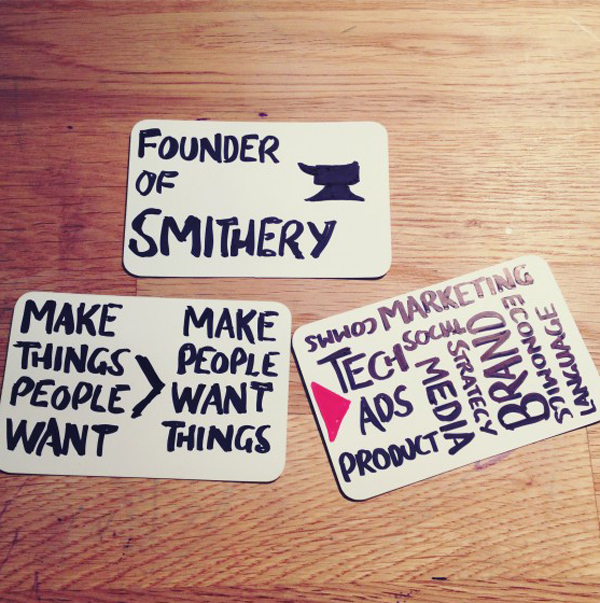




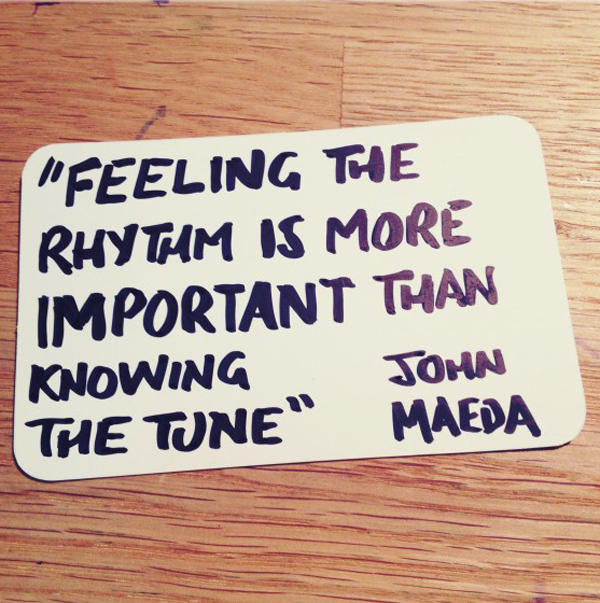


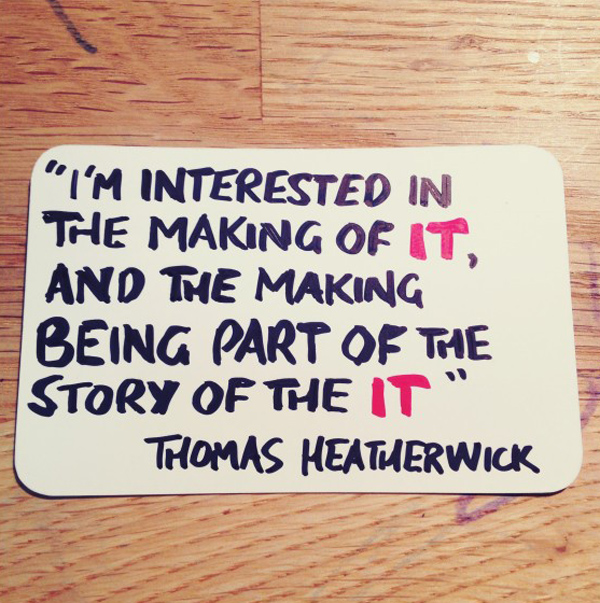




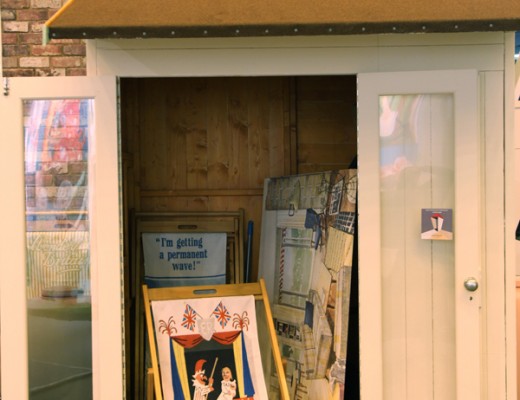
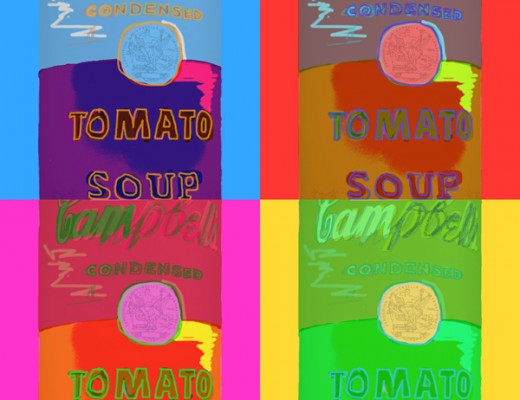

22 Comments
I love the idea of the Artefact cards! Speaking as someone who is pretty old skool and scribbles all their ideas and inspirations down in a black moleskine notebook I totally agree that we should value our ideas enough to want to write them down on nice paper. What my notebook doesn’t offer though is the opportunity to shuffle ideas around or have them on display as a constant reminder. Think I might have to give the cards a try.
Hi there Helen – that shuffling around is the interesting bit I’ve found – I have notebooks where I know that there’s a scrap of an idea in them, and have to scan through to find it, but with the cards it seems easier to collect, order and reorder the bits of projects you need. Like you, I’m also ‘weirdly old-school’ about this stuff, but I like to think of it as being ‘highly tactile’ 😉
Exactly, I have that same dilemma. Have so many Moleskine but can I find anything?? Nope! the cards were a revelation!
Check out my diary collection:-)
http://colourliving.co.uk/the-quest-for-a-diary-system
Loving all these ‘old school’ people around me. Fabulous!
Hey there Helen. That shuffling around is the interesting bit I’ve found – I have notebooks where I know that there’s a scrap of an idea in them, and have to scan through to find it, but with the cards it seems easier to collect, order and reorder the bits of projects you need. Like you, I’m also ‘weirdly old-school’ about this stuff, but I like to think of it as being ‘highly tactile’…
Helen, I’m telling you, as a fellow Moleskine user et cetera (Thanks Gerard) this is on a completely different level.
When I got mine, it felt like getting some memory cards game, only that this time you don’t have to hide and uncover but use them as you please. I have them on a wall, laid out, in my pockets. They changed everything because I can actually now ‘see’ what I’m doing and the visuals help me sometimes to think deeper (if that makes sense).
Anyway, seriously, give them a go. If you don’t like them I’ll gladly buy them off you x
Hi John! As a practitioner of the “anti-process” (great phrase, by the way, John!) – and a proud owner of Artefacts cards myself – this really did resonate with me.
There’s so much swirling around in my head right now so I’ll just get out what’s uppermost in my mind in no particular order.
I abhor focus groups, market research and most people recoil in horror when I tell them that I’m setting up a business without them. It would mean keeping an eye on “the audience” which, I feel, would interrupt my “flow”. Who can tell what really goes on in the minds of others or why they respond to certain products/ideas the way they do, anyway? No-one.
I’m so much more interested in the journey or the “making being part of the story of IT” as Thomas Heatherwick puts it. Creativity or the process thus becomes its own reward.
“Don’t just do something, stand there.”
I’m definitely going to copy this out and tape it to my wall – genius!
I find that the harder I work at something, the less likely I am to make any progress. Playing/having fun, letting go or doing something completely different instead yields greater results.
Thanks for the food for thought, John and well done on another fab Creative Process, Tina! xo
Hey Chi – there’s a great phrase (which I attribute to my friend @tobybarnes) about ‘designing for one’ – making something with a very specific person (or yourself) in mind, and then seeing how it bounces around in culture afterwards. I still think it’s interesting to have feedback loops, no matter how formally or informally, with people after that, but it definitely helps with flow to keep focused in the first stages of building.
Love that you felt the same as me when you read Annie’s post on this. We both jumped on it…
John and Chi, isn’t it true that most inventions, ideas et cetera are based on the inventors ‘likes/dislikes,opinions’ so the idea of ‘designing for one’ makes complete sense. However, I also agree that as soon as the idea pops, release it to others and see what the ‘wider audience’ thinks.
There is a danger of taking ONES idea to far without consulting ‘peers’ rather than focus groups!
Steve Jobs laughed at Market Research, but then he knew what we wanted before we knew it! I wonder whether this gift has now left the Apple Brand and is the reason for it’s ‘temporary’ decline?
Ah, the ever so brilliant Thomas Heatherwick… pearls of wisdoms indeed!!!
The notion of working hard vs working smart and having fun is always of interest to me. When in the Zone, stuff just flows but the important part is to be ‘showing up’ all the time in order to get in the Zone. I think that’s something that John does extremely well and I have to get better at. A author once described it as: you have to show up every day from 9-6 for the muse to visit you….
Glad you’re enjoying the series darling xx
Now this is odd, I have a little obsession with plain white postcards. I buy packs and use them in a similar way to the Artefact cards. (I was going to write my reply on one and send in a photograph but it involved techy skills, Tina, I know you’ll understand)
I also have a pack of Eno’s and Schmidt’s Oblique Strategies, now an app on my phone, and used when feeling stuck. I found them displayed as used artefacts at the David Bowie Is exhibition at the V&A, and his method of cutting up lyrics and rearranging them came to mind with the way you shuffle and structure your artefact cards to shape your ideas.
This is a fascinating and inspiring article on creativity and love the analogy of exposing ideas to the oxygen of people. I’m now inspired to expose some ideas, grab a pack of cards and spend a day in the wild x
Hello Nicola – the Bowie and Eno angle is a fascinating one – it’s generally referred to as ‘cut-up technique’, and was widely used by Dadaists. You create new works by “cutting up” existing pieces and rearranging. Another protagonist was William S Burroughs, and one of his most famous quotes (“When you cut into the present, the future leaks out”) is about the technique. Constantly being able to find and develop new connections is a really useful thing, whatever you’re using it for.
“When you cut into the present, the future leaks out” – gosh, not heard that one before!! Brilliant!
“Constantly being able to find and develop new connections is a really useful thing, whatever you’re using it for.” So true!!
Hahaha. Yes, that bit could have been the end of you:-) Interesting you’re obsessed with white postcards.
Also, I need to own up here. I have so far only used the yellow side of the cards and am waiting to see how to use the white….maybe make the yellow the main headings? Oh, I don’t know, need to experiment!
A pack of Eno’s and Schmidt’s Oblique Strategies – it seems like everyone is bringing these out. I have some Methods cards from IDEO (also now as an app) and Roger von Oech’s Creative Whack Pack…. interesting link to the David Bowie exhibition and cutting up lyrics and rearranging!
Thanks lovely xx
Hi John – thanks for your reply. The cut-up technique has been twirling around in my head again since seeing the exhibition and then reading your article today proves the interconnectedness of everything.
Thanks for this John.
I am often fascinated by how the simplest of ideas usually have the most impact. That is not to denigrate the Artefact Cards – on the contrary, I think their simplicity is the star feature.
I don’t think I have a creative process (either). I tend to just do something and see what happens. Business plans and strategies fill me with dread and suck the notion of creativity dry.
I have a sense that your creative process isn’t a process at all… that you simply ‘do’, just like the blacksmith in your example.
Off-the-shelf processes are all too often mind-numbing, in my opinion. I’ve tried many and it feels as though they are attempting to define or fix creativity. I love that you weren’t going to have a process for Smithery – just turn up and help solve problems. Your wisdom, experience, knowledge etc. would kick in in the moment (at least that’s what I tell myself in my case). I’ve tried processes in the past… but find a ‘structured free-for-all’ to be much more accommodating to my creative efforts. Perhaps that’s how I see the Artefact Cards.
I wholeheartedly agree when you say – “the last thing we need to tie ourselves down with [is] another set of constraints.”
Oh, why is it that the simplest ideas are ALWAYS the best? It’s a little like Haiku… why is it so potent?
You realise that this series is alos for me:-) I re-write my thoughts on my Creative Process all the time… so am fascinated to learn from others. I know what you mean by business plans:-)
I’m in 2 minds as of whether the Creative Process is JUST a process or whether it can be enhanced by being aware and ‘tricking’ones mind into it. Maybe like working out in a gym. If we were to do the same things every time we work out, the body would get used to it and there won’t be many results. We have to trick the bosy in thinking – what’s coming next? Is it the same with the Creative Process I wonder? Do we have to trick our mind in coming up with gems by using certain techniques and tools (artefact cards)? I believe so…
Of course, that does not explain the Creative Process but isn’t that part of it??
Hmmm, ned to ponder more on this. ‘Just turn up and solve the problem’ is great on one hand but if we want to build something lasting and sustainable, there needs to be a process in place…
So, the question here might be, how do we define ‘The Process”… does the word in itself conjure up images and experiences we’ve all had in the past that haven’t served us? I think for you Gerard, that might be the case! I feel less bothered by the terminology.
Thanks G xx
Hi John, thank you for sharing your creative process with us. As someone who jots ideas down on the back of envelopes & napkins, I think the Artefact cards are a great idea and one I’ll use in the future.
Give them a try. I think your daughters would like them too… x
I love how perfectly wrapped up this feels, what John is sharing here.
Access. Build. Cultivate. It makes complete sense. And I couldn’t be receiving this message at a better time. At the moment, I’ve been doing a lot of sitting around with people and speculating. Making group decisions is quite an interesting endeavour. I think I need to present some people with this post 🙂
Thanks to you both, John and Tina.
Xx.
Haha. I think I know what you mean. And yes, from knowing what you’re up to at the moment it seems that they will benefit from this process and maybe even from the cards.
Thanks Holly x
This is wonderful… I have just been down the internet rabbit hole for 45mins, following artefact cards/interviews. I love the cards, I am a list writter, jotter downer and doodler. I now feel like I need these in my life 🙂
Thanks Tina and John xx
“I have just been down the internet rabbit hole for 45mins, following artefact cards/interviews” – I’d say 45 minutes well spent, wouldn’t you???
Full of inspiration and nuggets, right?
Never mind you my love, what about Miss S? I can just see her developing an empire, for that she will need the help of John’s cards: a dolls house, a teepee, chicken coop extension, her tea parties et cetera et cetera… the woman is busy and needs a system:-)
You will love them – all the way in AUSTRALIA! xx
[…] my other friend, john willshire and his unique artefact cards. Once again, john has featured in my creative process series and you can read all about the cards there. With brand new packaging and now made in the UK, […]